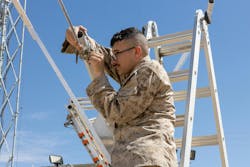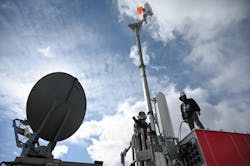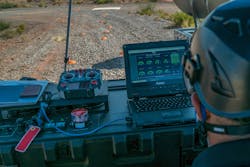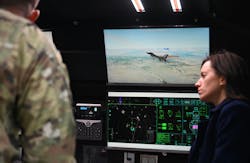5G Takes Its Place Leading-Edge Military Communications Systems
Fifth-generation (5G) communications and networking is transforming how military forces exchange information and coordinate how they respond to threats, as 5G holds the promise of secure wide-bandwidth digital links from orbital space to the leading edge of the battlefield.
Military fifth-generation networking, largely adapted from commercial 5G technology, offers unprecedented advantages high speeds, wide bandwidth, and low latencies; security and stealth; better coordination than ever before; affordability and scale of open-systems standards; and a pathway to widespread use of artificial intelligence (AI) and machine learning everywhere on the battlefield.
Speed and bandwidth
"The robustness and resilience of 5G communications is critical to the power you get from network-enabled warfare," says Patrick Lardieri, principal architect of cyber support operations at Lockheed Martin Corp. in Bethesda, Md. "5G brings with it several things that can really help. It has very robust communications in higher bandwidth and lower latencies that can provide direct user access links that are higher bandwidth than some of the existing communications networks that are in play today in the tactical world."
Lardieri made his comments in late July at the Military + Aerospace Electronics-hosted webinar, "How can military 5G help transform communications and enable applications?" Also speaking at this webinar were Baljit Chandhoke, product manager of RF Products at the Microchip Technology Discrete Products Group in Chandler, Ariz.; and Randy Cox, vice president of product management and business operations at Wind River Systems in Alameda, Calif.
5G communications designers are looking ahead to future military and civil applications with widespread millimeter wave signals that will operate on frequencies between 24 and 300 GHz. The millimeter wave frequency range offers military and civil authorities applications like control of swarming unmanned aerial vehicles (UAVs); augmented- and virtual reality for simulation, training and mission rehearsal; real-time intelligence, surveillance, and reconnaissance (ISR); distributed command and control; smart warehousing and logistics; and dynamic RF spectrum use.
"5G millimeter wave brings to the battlefield, as the technology matures, the latest spectrum, which is at 28 gigahertz in the U.S., and 24.5 GHZ in China and other parts of the world," says Microchip's Chandhoke. "New advancement in 5G will bring high-speed connectivity to the battlefield, while minimizing vulnerabilities like electronic warfare jamming. New generations of millimeter wave communications solutions offer speed that can provide ultra-wide bandwidth and low latency for broadband communications, which is increasing the amount of information we can share to support real-time decision making."
Applications of 5G
For the military, 5G could improve intelligence, surveillance, and reconnaissance (ISR) systems and signal processing, enable new command-and-control applications, and streamline logistics. 5G also could give the military broad access to augmented and virtual reality, 5G smart warehousing, distributed command and control, and dynamic spectrum use.
"Applications of 5G include mobile disaggregated command posts," says Lockheed Martin's Lardieri. "It would support Marines on the move and expeditionary basing operations while maintaining high-quality access to information. There is an opportunity to interconnect different networks for information, and connect sensors to shooters." He suggests other potential 5G applications include smart warehousing, logistics distribution, and virtual reality-assisted medical diagnosing.
5G could broaden the military's use of virtual reality, not only in military operations, but also in simulation and mission rehearsal in 5G enabled virtual reality in air, land, and sea missions. "Every second counts in defense," says Microchip's Chandhoke. "Getting seamless ultra-fast connectivity gives a real-time picture of land, sea, and air under stressful conditions. 5G enhances connectivity and enhances the ability to deliver decisive action even faster."
Perhaps the most promising future applications of 5G communications involve automation, artificial intelligence (AI), and machine learning. In terms of learning and experience, life cycle management from day zero to day 2 operations is critical today," points out Wind River's Cox. "As we move forward in the evolution of networks, the use of automation is becoming more and more critical, and is absolutely required as it gets more complex, and also to reduce cost.
Some experts in the field are looking beyond 5G to the applications that future 6G applications might offer. "6G has a huge opportunity for new applications that could be spun-up quickly and for AI and Machine learning for the warfighter to get critical data for decision making, with higher data rates, lower latency, and massive device distribution," Cox says.
Integrating new and legacy systems
Part of the power of 5G for the military is its potential to stitch together new and legacy communications and networking systems. "For DOD [the U.S. Department of Defense] 5G is a unifying technology, to ensure seamless communications across all environments," says Microchip's Chandhoke. "Unification across 5G is a game-changing technology for the military."
Part of that will be the military's ability to draw enterprise and tactical computer networking together more closely than ever. "Another benefit is enterprise and tactical deployments so that DOD can leverage 5G," Chandhoke continues. "The tactical version of 5G is ideal for smaller groups of people on the battlefield to deploy 5G solutions. DOD can support a wide range of use cases quickly, and support the comprehensive coverage that 5G offers with extreme bandwidth, with standardized interoperabilities, common applications, and hardware that are interoperable. For the DOD that means global partners can talk to each other, with improved communications, cost savings, and the ability to streamline security."
5G also provides the military with the ability to integrate users over backhauls and reachbacks, points out Lockheed Martin's Lardieri. "Through very solid integration with wired Internet and other communications infrastructure, new channel models like the non terrestrial networking capabilities to allow direct access from space."
Lockheed Martin is integrating 5G as a primary communications technology with other existing military communications technologies in terrestrial, seaborne, or space, or airborne assets, Lardieri says "We can use 5G as a sort of interlinking or inter-networking capability to provide robust backhauls. 5G can provide this interlocking web that will allow us to interconnect many disparate communications systems while providing new and enhanced user access and backhaul communications links that can supplement those existing ones."
Lardieri also explains Lockheed Martin approach to what he calls a "hybrid base station" "where we integrate 5G technology with other more traditional DOD-like technologies, showing how we can provide alternative access so that operators and users can get into the network of the base station using waveforms other than the standard 5G waveform. This can help in contested space and security, and spectrum relocation for some of that initial access."
In this way, systems designers can bring 5G into useful applications using "things that allow us to take 5G and integrate it with other existing networks. "This is a real criticality to the military and aerospace community."
It doesn't make sense not to integrate existing military communications systems into new 5G-based systems, Lardieri points out. "We have to respect that we have trillions of dollars in legacy military equipment, and we're not going to go replace all that anytime soon in one fell swoop."
For now, Lardieri says systems designers "are looking for inter-networking solutions to bridge these communications islands with different networking technologies and interoperability standards. 5G is highly disaggregated, ready for edge cloud deployment, and looking to pull hyperconverged infrastructures out to the edge. It also creates the opportunity for other services like interoperability services to do message translations, bridges to other networks, 5G offers these great user access capabilities in high performance and low latency, and the ability to link into other commercial infrastructures, and to leverage legacy military existing capabilities."
Security and detectability
An effective military 5G infrastructure cannot exist without secure links able to resist enemy attempts to jam, disrupt, eavesdrop, or hack into sensitive communications. "Security is a big one," says Lockheed Martin's Lardieri. "We need to ensure confidentiality, and operate in a way that does not allow users to be detected or geo-located."
One advantage to the military may lie in the military-specific and non-commercial nature of many legacy military communications. The DOD has spectrum of its own that we could leverage in some cases, Lardieri says. "If we put 5G in the hands of people operating in foreign lands in potentially military maneuvers, we need to make sure they are safe and secure. Commercial waveforms may not provide the types of protection to geo-location or detection of the users, as well as they may not provide as much security for the users.
Using sophisticated encryption in 5G communications is an obvious consideration -- but should be done in the right way," Lardieri points out. "We need to integrate encryption protocols and waveforms in a way that doesn't destroy performance or overturn the entire architecture. Using the right interfaces and leveraging the right industry standards that are being opened up is one of the key considerations to effectively moving this forward -- especially for tactical systems on the move."
When it comes to the less-discussed shortcomings of military 5G technology, security perhaps is top of the list. "Does 5G bring new security challenges? It does because it uses more software-driven information technology," Lardieri says. "Software today is a great surface for adversary attack. As we bring more software control and networking, we need to bring a higher standard of supply chain security and software cyber security to ensure that adversaries can't exploit that software complexity. Will be a higher standard of security."
The vulnerability of 5G to enemy detection also is a big concern. "5G is protected, but to anyone with sophisticated equipment it is detectable and subject to attack," says vice president of product management and business operations at Wind River Systems in Alameda, Calif. "New techniques to prove the resilience of the 5G network are needed, such as mesh connectivity and redundant paths. Software-defined radios can provide alternative paths to degraded or contested networks, and new backhaul networks can help link 5G networks and satellites, 5G, and terrestrial networks."
Such a challenge might not be easy to overcome. "5G from a commercial standpoint is going to require a need for military-level security to protect highly sensitive and classified information at every level," Cox says. Zero trust is really a must. Susceptibility to RF jamming also is a concern."
Standards and interoperability
U.S. military officials are considering open-systems standards for the hardware and software used in 5G communications. In 2022 the DOD launched the Open6G project that revolves around open radio access networks, also called Open RAN. Open6G is a new industry-university effort that seeks to boost 6G systems research on Open RAN. The DOD also is looking to enable open-systems standards within 5G networks. Military experts are working with the National Telecommunications and Information Administration (NTIA) with $7 million in awards.
"5G has been rolled out commercially for years, however operations are at an inflection point in 5G where they are converting from a traditional network to a more open disaggregated and edge-computing network with many vendors supplying different network elements," says Wind River's Cox. "This can drive flexibility of the network, reduce total cost of ownership, and innovation into the network as well. This will be applicable to the defense industry as well."
About the Author
John Keller
Editor-in-Chief
John Keller is the Editor-in-Chief, Military & Aerospace Electronics Magazine--provides extensive coverage and analysis of enabling electronics and optoelectronic technologies in military, space and commercial aviation applications. John has been a member of the Military & Aerospace Electronics staff since 1989 and chief editor since 1995.




